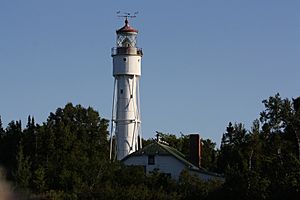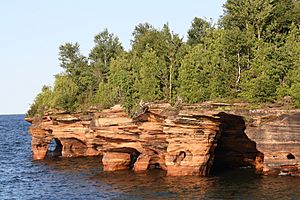Devils Island (Wisconsin) facts for kids
Devils Island is one of the twenty-two beautiful Apostle Islands located in northern Wisconsin. It sits in the western part of Lake Superior, near the Bayfield Peninsula. This island has been known by several names over time, like Louisiana Island, Barney and Lamborn's Island, Brownstone Island, and Rabbit Island.
Devils Island rises about 50 feet (15 meters) above Lake Superior's water level. No people live on the island year-round, but volunteers from the National Park Service stay there during the summer. The island is managed as part of the Apostle Islands National Lakeshore, which helps protect its natural beauty.
Contents
Why is it Called Devils Island?
The name "Devils Island" has an interesting story. In 1899, a politician and writer named Samuel Fifield wrote that local Native American tribes, the Ojibwe, believed the island was home to Matchimanitou, an "evil spirit." They thought Kitchie-Manitouo, the "great spirit," had trapped this evil spirit there. This is why it got its name.
When the waves on Lake Superior are big, they crash into the island's many sea caves. The rumbling sound can be heard far away from the shore. People who live nearby say the Ojibwe people thought this noise was the sound of evil spirits. However, some modern Native scholars are not sure if this explanation is completely accurate.
Amazing Sea Caves and Rocks
Devils Island is famous for its amazing rock formations and sea caves, especially along its northern shore. These caves are a favorite spot for kayakers who love to paddle in and out of them on calm days.
The caves were formed from sandstone rock that is a billion years old! This red and gold sandstone was laid down by ancient streams flowing from western hills. Over about a million years, the climate changed, creating a thick layer of sandstone, about 1800 feet (550 meters) deep. The rocks have colorful layers. You can even see ripples on the rocks, just like the ripples you might see on a sandy lake bottom today. These ripples were made by gentle waves a billion years ago!
The Devils Island Lighthouse
At the northern end of the island stands the Devils Island Light. During the busy summer months, a volunteer ranger works there. Visitors can climb the lighthouse tower with the volunteer and explore the original keeper's quarters, which were built in 1894.
This lighthouse is special because it has its original 3rd order Fresnel lens. This is the only lighthouse in the Apostle Islands that still has its first lens! If you look closely, you can see cracks and damage on the lens. This happened when the US Coast Guard removed it in 1989. But after people spoke up and took legal action, the Park Service was able to return the lens to the lighthouse in 1992.
Exploring the Island's Trails
Visitors are welcome to walk around the lighthouse grounds and enjoy the many trails on the island. From the light station, there are short trails to the east "landing" and a loop trail to the west "landing." There's also a longer trail that goes down the middle of the island to the boathouse and dock at the south end.
Old Engine House
To the east of the lighthouse, you'll find an old engine house. This building, likely finished in 1901, was used to pull supplies up from the landing. It's unique because it's the only building on the island made from sandstone quarried right there.
Unique Plant Life
You might also spot an old bulldozer along the trail to the west landing. This army surplus bulldozer was once used in Greenland. It's thought that a rare type of grass called heath rush was carried to Devils Island on its tracks!
Northernmost Point of Wisconsin
The very northern tip of Devils Island is the northernmost point of the entire state of Wisconsin!





